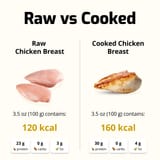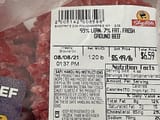https://www.modus-energy.com/raw-vs-cooked/
>Whether broiled, baked, or sautéed, animal meat loses approximately 25% of its mass when cooked. As meat cooks, water is driven off (same applies for baked potato!). Only water is lost; the caloric and macronutrient values do not change despite the change in scale weight.
https://fitia.app/en/learn/post/raw-vs-cooked-nutritional-comparison/
When you cook food, it either loses or absorbs water, changing its weight but not its nutrient content.
Proteins (Chicken, Fish, Meat):
Cooking reduces weight because water evaporates.
Example: Cooking 3.5 oz (100 g) of chicken breast, which contains 23 g of protein, will leave you with 2.6 oz (75 g) after cooking. But the total amount of protein stays the same—only the water is lost.
So, if you compare 3.5 oz raw to 3.5 oz cooked, the cooked portion will appear to have more calories and protein per ounce because it’s more concentrated. In reality, those 3.5 oz cooked originally weighed about 4.7 oz (133 g) when raw. This explains why cooked food can have higher calories and protein per ounce than its raw counterpart.



